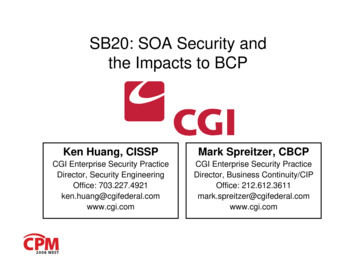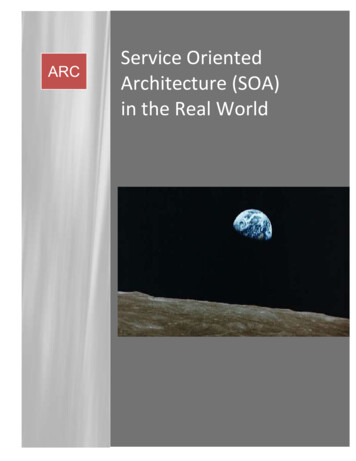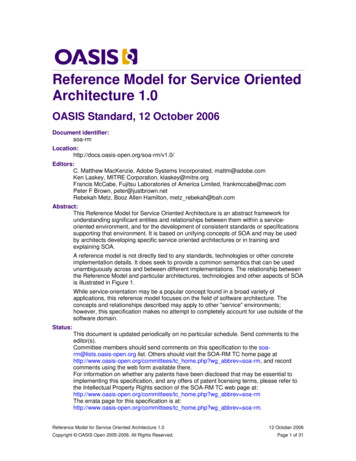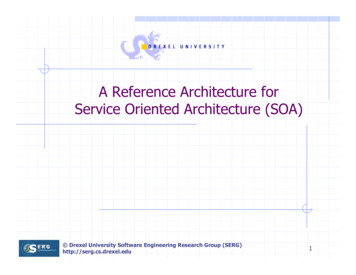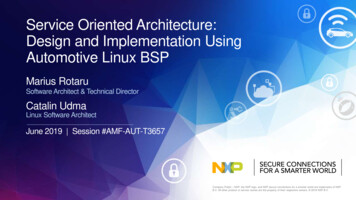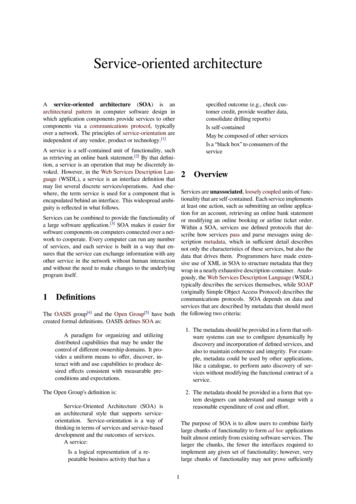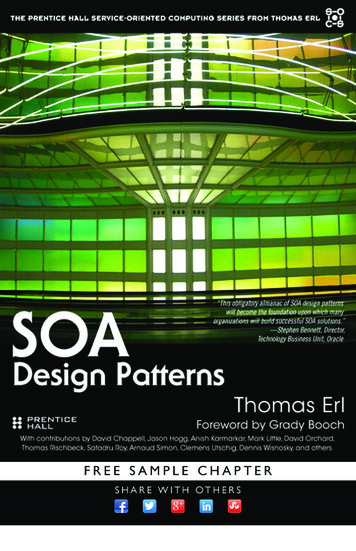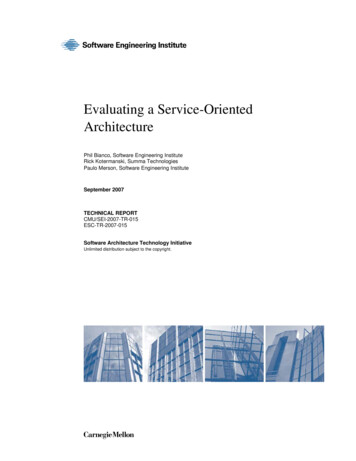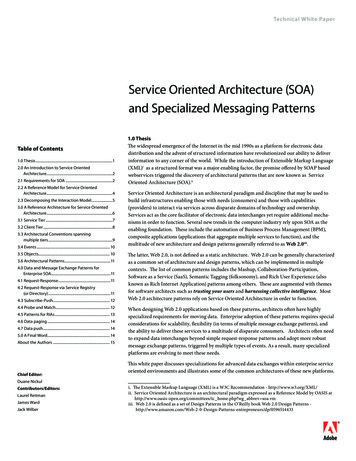
Transcription
Technical White PaperService Oriented Architecture (SOA)and Specialized Messaging PatternsTable of Contents1.0 Thesis.12.0 An Introduction to Service OrientedArchitecture.22.1 Requirements for SOA.22.2 A Reference Model for Service OrientedArchitecture.42.3 Decomposing the Interaction Model.53.0 A Reference Architecture for Service OrientedArchitecture.63.1 Service Tier.73.2 Client Tier.83.3 Architectural Conventions spanningmultiple tiers.93.4 Events. 103.5 Objects. 103.6 Architectural Patterns.114.0 Data and Message Exchange Patterns forEnterprise SOA.114.1 Request-Response.114.2 Request-Response via Service Registry(or Directory).114.3 Subscribe-Push. 124.4 Probe and Match. 124.5 Patterns for RIAs. 134.6 Data paging. 144.7 Data push. 145.0 A Final Word. 14About the Authors. 15Chief Editor:1.0 ThesisThe widespread emergence of the Internet in the mid 1990s as a platform for electronic datadistribution and the advent of structured information have revolutionized our ability to deliverinformation to any corner of the world. While the introduction of Extensible Markup Language(XML)i as a structured format was a major enabling factor, the promise offered by SOAP basedwebservices triggered the discovery of architectural patterns that are now known as ServiceOriented Architecture (SOA).iiService Oriented Architecture is an architectural paradigm and discipline that may be used tobuild infrastructures enabling those with needs (consumers) and those with capabilities(providers) to interact via services across disparate domains of technology and ownership.Services act as the core facilitator of electronic data interchanges yet require additional mechanisms in order to function. Several new trends in the computer industry rely upon SOA as theenabling foundation. These include the automation of Business Process Management (BPM),composite applications (applications that aggregate multiple services to function), and themultitude of new architecture and design patterns generally referred to as Web 2.0iii.The latter, Web 2.0, is not defined as a static architecture. Web 2.0 can be generally characterizedas a common set of architecture and design patterns, which can be implemented in multiplecontexts. The list of common patterns includes the Mashup, Collaboration-Participation,Software as a Service (SaaS), Semantic Tagging (folksonomy), and Rich User Experience (alsoknown as Rich Internet Application) patterns among others. These are augmented with themesfor software architects such as trusting your users and harnessing collective intelligence. MostWeb 2.0 architecture patterns rely on Service Oriented Architecture in order to function.When designing Web 2.0 applications based on these patterns, architects often have highlyspecialized requirements for moving data. Enterprise adoption of these patterns requires specialconsiderations for scalability, flexibility (in terms of multiple message exchange patterns), andthe ability to deliver these services to a multitude of disparate consumers. Architects often needto expand data interchanges beyond simple request-response patterns and adopt more robustmessage exchange patterns, triggered by multiple types of events. As a result, many specializedplatforms are evolving to meet these needs.This white paper discusses specializations for advanced data exchanges within enterprise serviceoriented environments and illustrates some of the common architectures of these new platforms.Duane NickulContributors/Editors:Laurel ReitmanJames WardJack Wilberi. The Extensible Markup Language (XML) is a W3C Recommendation - http://www.w3.org/XML/ii. Service Oriented Architecture is an architectural paradigm expressed as a Reference Model by OASIS athttp://www.oasis-open.org/committees/tc home.php?wg abbrev soa-rmiii. Web 2.0 is defined as a set of Design Patterns in the O’Reilly book Web 2.0 Design Patterns epreneurs/dp/0596514433
2.0 An Introduction to Service Oriented ArchitectureService Oriented Architecture (SOA) is a paradigm for organizing and utilizing distributedcapabilities that may be under the control of different ownership domains and implementedusing various technology stacks. In general, entities (people and organizations) create capabilities to solve or support a solution for the problems they face in the course of their business. It isnatural to think of one person’s needs being met by capabilities offered by someone else; or, inthe world of distributed computing, one computer agent’s requirements being met by a computeragent belonging to a different owner. The term owner here may be used to denote differentdivisions of one business or perhaps unrelated entities in different countries.There is not necessarily a one-to-one correlation between needs and capabilities; the granularityof needs and capabilities vary from fundamental to complex, and any given need may require acombination of numerous capabilities while any single capability may address more than oneneed. One perceived value of SOA is that it provides a powerful framework for matching needsand capabilities and for combining capabilities to address those needs by leveraging othercapabilities. One capability may be repurposed across a multitude of needs.SOA is a “view” of architecture that focuses in on services as the action boundaries between theneeds and capabilities in a manner conducive to service discovery and repurposing.2.1 Requirements for SOAFigure 2-1 shows an example of an information system scenario that could benefit from amigration to SOA. Within one organization, three separate business processes use the samefunctionality, each encapsulating it within an application. In this scenario, the login function,the ability to change the user name, and the ability to persist it are common tasks implementedredundantly in all three processes. This is a suboptimal situation because the company has paidto implement the same basic functionality three times.Process 1Process 2Process 3Log in / AuthenticateLog in / AuthenticateLog in / AuthenticateNameChangeformPersistName &AddressNameChangeformPersistName &AddressNameChangeformPersistName &AddressPayroll Calc()Insurance ClaimER PlanningAudit performanceClaim detailsConfigure productionMake DepositFile to InsuranceAgentModify AssemblyLine systemFigure 2.1 – three business processes within one company duplicating functionalityMoreover, such scenarios are highly inefficient and introduce maintenance complexity within ITinfrastructures. For example, consider an implementation in which the state of a user is notsynchronized across all three processes. In this environment users might have to remembermultiple login username/password tokens and manage changes to their profiles in three separateareas. Additionally, if a manager wanted to deny a user access to all three processes, it is likelythat three different procedures would be required (one for each of the applications). Corporate ITworkers managing such a system would be effectively tripling their work –and spending more forsoftware and hardware systems.2
In a more efficient scenario, common tasks would be shared across all three processes. This canbe implemented by decoupling the functionality from each process or application and building astandalone authentication and user management application that can be accessed as a service. Insuch a scenario, the service itself can be repurposed across multiple processes and applicationsand the company owning it only has to maintain the functionality in one central place. Thiswould be a simple example of Service Oriented Architecture in practice. The resultant ITinfrastructure would resemble Figure 2.2.Process 1Process 2Process 3Payroll Calc()Insurance ClaimER PlanningAudit performanceClaim detailsConfigure productionMake DepositFile to InsuranceAgentModify AssemblyLine systemShared UserAccount TasksService BusLog in / AuthenticateNameChangeformPersistName &AddressOther ServicesFigure 2.2 – three business processes repurposing one service for common tasks.In figure 2.2, the shared user account tasks have been separated from each process and implemented in a way that enables other processes to call them as a service. This allows the sharedfunctions to be repurposed across all three processes. The common service bus is really a virtualenvironment whereby services are made available to all potential consumers on a fabric. This istypically referred to as an Enterprise Service Bus (ESB) and has a collection of specializedsubcomponents including naming and lookup directories, registry-repositories, and serviceprovider interfaces (for connecting capabilities and integrating systems) as well as a standardized collection of standards and protocols to make communications seamless across all connected devices. Advanced ESB vendors have tools that can aggregate services into complexprocesses and workflows.In the preceding example of SOA, the complications were relatively minor as the entire infrastructure existed within one domain. In reality, enterprise SOA is much more difficult becauseservices may be deployed across multiple domains of ownership. To make interactions possible,mechanisms have to be present to convey semantics, declare and enforce policies and contracts,the ability to use constraints for data passed in and out of the services as well as expressions forthe behavior models of services. The ability to understand both the structure and semantics ofdata passing between service endpoints is essential for all parties involved.While most SOA examples are typically shown as a request-response interaction pattern, morerobust exchanges are required. Additionally, modern service platforms also need the flexibilityto support these advanced message exchange patterns. Before discussing the platform andreference architecture, this white paper will briefly delve into SOA in more detail.3
2.2 A Reference Model for Service Oriented ArchitectureAs with any other architecture, Service Oriented Architecture can be expressed in a manner thatis decoupled from implementation. Software architects generally use standardized conventionsfor capturing and sharing knowledge. This group of conventions is often referred to as anArchitecture Description Language (ADL). There are also several normalized artifacts used tofacilitate a shared understanding of the structure of a system, its major components, therelationships between them, and their externally visible properties. This white paper will makeuse of two special types of these artifacts – a Reference Model and Reference Architecture.A Reference Model is an abstract framework for understanding significant entities and relationships between them. It may be used for the further development of more concrete artifacts suchas architectures and blueprints. Reference models themselves do not contain a sufficient level ofdetail sufficient to enable the direct implementation of a system. In the case of a reference modelfor SOA, the Organization for the Advancement of Structured Information Systems (OASIS) hasa standard Reference Model for SOA, shown in Figure 2.3, that is not directly tied to anystandards, technologies, or other concrete implementation details.In order for SOA to be meet these challenges, services must have accompanying servicedescriptions to convey the meaning and real world effects of invoking the service. Thesedescriptions must additionally convey both semantics and syntax for both humans and applications to use.Each service has an interaction model, which is the externally visible aspects of invoking aservice. In this paper, this will be decomposed further to examine the data service aspects ServiceReal worldeffectInteractionContract& PolicyFigure 2.3 – the core OASIS Reference Model for Service Oriented ArchitectureVisibility and Real World Effect are also key concepts for SOA. Visibility is the capacity forthose with needs and those with capabilities to be able to see and interact with each other. This istypically implemented by using a common set of protocols, standards, and technologies acrossservice providers and service consumers. For consumers to determine if they can interact with aspecific service, Service Descriptions provide declarations of aspects such as functions andtechnical requirements, related constraints and policies, and mechanisms for access or response.The descriptions must be in a form (or can be transformed to a form) in which their syntax andsemantics are widely accessible and understandable. The execution context is the set of specificcircumstances surrounding any given interaction with a service and may affect how the serviceis invoked.Since SOA permits service providers and consumers to interact, it also provides a decision pointfor any policies and contracts that may be in force. The purpose of using a capability is torealize one or more real world effects. At its core, an interaction is “an act” as opposed to “an4
object” and the result of an interaction is an effect (or a set/series of effects). Real world effectsare, then, couched in terms of changes to this shared state. This may specifically mutate theshared state of data in multiple places within an enterprise and beyond.The concept of policy also must be applicable to data represented as documents and policies mustpersist to protect this data far beyond enterprise walls. This requirement is a logical evolution ofthe “locked file cabinet” model which has failed many IT organizations in recent years. Policiesmust be able to persist with the data that is involved with services, wherever the data persists.A contract is formed when at least one other party to a service oriented interaction adheres to thepolicies of another. Service contracts may be either short lived or long lived.2.3 Decomposing the Interaction ModelWhereas visibility introduces the possibilities for matching needs to capabilities (and vice versa),interaction is the act of actually using a capability via the service. Typically mediated by theexchange of messages, an interaction proceeds through a series of information exchanges andinvoked actions. There are many facets of interaction; but they are all grounded in a particularexecution context – the set of technical and business elements that form a path between thosewith needs and those with capabilities. Architects building Rich Internet Applications (RIAs),are faced with special considerations when designing their systems from this perspective. Theconcept of “Mashups” surrounds a model whereby a single client RIA may actually provide aview composed by binding data from multiple sources persisting in multiple domains acrossmany tiers.ServiceDescriptionBehaviormodeAction modelProcess Figure 2.4 – a decomposition of the Interaction Model (courtesy of OASIS Reference Model for SOA)As depicted in Figure 2.4, the interaction model can be further decomposed into a data modeland behavior model. The data model is present in all service instances. Even if the value is“null”, the service is still deemed to have a data model. The data models are strongly linked to thebehavior models. For example, in a Request-Response behavior model, the corresponding datamodel would have two components – the input (service Request) data model and the output(service Response) data model. Data models may be further specialized to match the behaviormodel if it is other than “Request-Response”.The behavior model is decomposable into the action model and the process model. The sequenceof messages flowing into and out of the service is captured in the action model while the service’s5
processing of those signals is captured in the processing model. The processing model ispotentially confusing as some aspects of it may remain invisible to external entities and its innerworking known only to the service provider.3.0 A Reference Architecture for Service Oriented ArchitectureA reference architecture is a more concrete artifact used by architects. Unlike the referencemodel, it can introduce additional details and concepts to provide a more complete picture forthose who may implement a particular class. Reference architectures declare details that wouldbe in all instances of a certain class, much like an abstract constructor class in programming.Each subsequent architecture designed from the reference architecture would be specialized for aspecific set of requirements. Reference architectures often introduce concepts such as cardinality, structure, infrastructure, and other types of binary relationship details. Accordingly,reference models do not have service providers and consumers. If they did, then a referencemodel would have infrastructure (between the two concrete entities) and it would not longer be amodel.The reference model and the reference architecture are intended to be part of a set of guidingartifacts that are used with patterns. Architects can use these artifacts in conjunction withothers to compose their own SOA. The relationships are depicted in Figure rchitecturesInputaccountsforRelatedrectoriesDi ModelsArchitecture WorkconstrainedbyStandardsEISRelated WorkuseSOA ImplementationsConcreteFigure 3.1 – The architectural framework for SOA (Courtesy of OASIS).The concepts and relationships defined by the reference model are intended to be the basis fordescribing reference architectures that will define more specific categories of SOA designs.Specifically, these specialized architectures will enable solution patterns to solve particularproblems. Concrete architectures may be developed based upon a combination of referencearchitectures, architectural patterns, and additional requirements, including those imposed bytechnology environments. Architecture is not done in isolation; it must account for the goals,motivation, and requirements that define the actual problems being addressed. While referencearchitectures can form the basis of classes of solutions, concrete architectures will define specificsolution approaches.Architects and developers also need to bind their own SOA to concrete standards technologiesand protocols at some point. These are typically part of the requirements process. For example,when building a highly efficient client side Mashup application, a developer might opt for the6
ActionScript Messaging Format (AMFiv) to provide the most efficient communication betweenremote services and the client .NeutralityThe reference architecture shown in Figure 3.2 is not tied to any specific technologies, standards,or protocols. In fact, it would be equally applicable to a .NETv or J2EEvi environment and can beused with either the Web Service family of technologies, plain old XML-RPC (XML – RemoteProcedure Call), or a proprietary set of standards. This reference architecture allows developersto make decisions and adopt technologies that are best suited to their specific odelContainer/ModelRenderingRendering&& ationTierCommunicationCommunication ServicesServicesDesign,Development& GovernanceToolsStandard Technologies& Protocols- Consistent object & event models- Consistent architectural modelsServiceService InvocationInvocation iceService ContainerContainerCoreCore ServicesServicesBusinessBusiness ice ProviderProvider InterfaceInterfaceResource esLegacyLegacySystemsSystemsFigure 3.2 – A generic SOA Reference Architecture for implementing core Web 2.0 design patterns(Courtesy of O’Reilly Media)3.1 Service TierThe server side component of the reference architecture has a number of commonly usedcomponents. The Service Provider Interface is the main integration point whereby serviceproviders connect to capabilities that exist in internal systems in order to expose them asservices. These internal applications typically reside in a resource tier, a virtual collection ofcapabilities that become exposed as services so consumers can access their functionality. Serviceproviders may integrate such capabilities using numerous mechanisms, including using otherservices. In most cases, an enterprise will use the Application Programmatic Interface (API) ofthe system as provided by the application vendor.The Service Invocation Layer is where services are invoked. A service may be invoked when anexternal messages being received or, alternatively, it can be invoked by an internal system or by anon-message based event (such as a time out). It is essential to understand that services may beinvoked via messages from multiple sets of standards and protocols working together. Commonexamples of external service interface endpoints include: Asynchronous JavaScript and XML (AJAXvii), Simple Object Access Protocol (SOAP),iv. AMF - http://osflash.org/documentation/amfv. .NET is a trademark and technology from Microsoft ult.aspxvi. Java 2 Enterprise Edition is a trademark of Sun Microsystemsvii. Asynchronous JavaScript And XML is described on Wikipedia in more details athttp://en.wikipedia.org/wiki/Ajax (programming)7
XML Remote Procedure Call (XML-RPC), a watched folder being polled for content, an email endpoint, and other RESTviii style endpoints including plain old HTTP and HTTP/S.Services may also be invoked by local consumers including environments like J2EE and languagespecific interfaces (for example - Plain Old Java Objects or POJO’s).Each service invocation is often handed to a new instance of a service container. The servicecontainer is responsible for handling the service invocation request for its entire lifecycle, untileither it reaches a successful conclusion or failed end state. Regardless of its ultimate end state,the service container may also delegate responsibilities for certain aspects of the service’sruntime to other services for common tasks. These tasks typically include logging functions,archiving, security, and authentication, among others.To facilitate orchestration and aggregation of services into processes and composite applications,a registry-repository is often used. During the process design phase, the registry-repositoryprovides a single view of all services and related artifacts. The repository provides a persistencemechanism for artifacts during the runtime of processes and workflows. If multiple systemactors use and interact with a form, the repository can persist it while allowing access toprivileged individuals.Design, development and governance tools are also commonly used by humans to deploy,monitor, and aggregate multiple services into more complex processes and applications.3.2 Client TierWhile much attention has been focused on the server side aspects of SOA, less has been writtenabout the new breed of clients evolving for consuming services. The clients have evolved toembrace many common architecture and design patterns discussed in greater detail in the nextsection. A highly visible example of this is the ability of most modern browsers to subscribe toRSS endering&& ication ServicesServicesDesign,Development& GovernanceToolsResource TierFigure 3.3 – client application architectureStandard Technologies- Consistent object & event modelsAs depicted in Figure 3.3,&clientsmust have far morerobustarchitecturalcommunicationsservices than a- ConsistentmodelsProtocolsdecade ago. In fact, any communication standards, protocols and technologies (such as SOAPix,ActionScript Messaging Format, or XML-RPC) have to be implemented on both sides tofacilitate proper communications. Client side communications buses also need to monitor theServiceService InvocationInvocation LayerLayerstate of communications including potentially both synchronous and asynchronous exchangepatterns.ServiceRegistryBusinessBusiness Rules/Rules/RegistryCoreServiceCore ServicesServicesService toryTierThe main controller of each client application must be capable of launching various runtimeServiceProviderServiceProvider InterfaceInterfaceenvironments. Thisis typicallydone via launching one or more virtual machines that caninterpret scripting languages or consume bytecode as in Adobe Flash. The architecture for thesevirtual machines varies greatly depending upon the language used. Some compile an DirectoriesDatabasesDirectoriesEISate levelEISbytecode justin time to runa program whileothers mustbe launchedSystemsand makeRepositoryQueuesRepositoryQueuesSystemsviii. Representational State Transfer (REST) is an important component of Roy Fielding’s DissertationArchitectural Styles and the Design of Network-based Software Architectures http://www.ics.uci.edu/ fielding/pubs/dissertation/top.htmix. The Simple Object Access Protocol is a W3C Recommendation - http://www.w3.org/TR/soap/8
multiple passes over a script (usually once to check it for errors, another time to run the script,and a concurrent iteration to collect garbage and free up memory as it becomes possible toreallocate.Most modern clients have some form of data persistence and state management. This usuallyworks in conjunction with the clients’ communications services to allow the controller to usecached resources rather than attempting to synchronize states if communications are down.Additionally, rendering and media functionality specific to one or more languages is used toensure the view of the application is built in accordance with the intentions of the applicationdeveloper.The security models used by different clients also vary somewhat. The usual tenets are to preventunauthorized and undetected manipulation of local resources. In distributed computingarchitectures, identity (knowing who and what) is a major problem that requires a complexarchitecture to address. Each client side application must be architected in accordance with theacceptable level of risk based on the user requirements.3.3 Architectural Conventions spanning multiple tiersWhile examining the client and service tiers of the reference architecture, developers will notesome commonalities. Architects need to employ common models for determining whatconstitutes an object, what constitutes an event, how an event gets noticed or captured, whatconstitutes a change in state, and more. As a result, architecture must take note of severalcommon architectural models over all tiers of modern SOAs.First and foremost, the core axioms of service oriented architecture should be observed. Servicesthemselves should be treated as subservient to the higher level system or systems that use them.If you are deploying services to be part of an automated process management system, theservices themselves should not know (or care) what they are being used for.Services that are designed otherwise are architecturally inelegant for a number of reasons.First, if services were required to know the state of the overall process, state misalignment wouldlikely result if two services had differing states for even a fraction of a second. In such instances,errors might be thrown when this is detected or worse, developers would have to rely on using aseries of synchronous calls to services rather than forking a process into asynchronous calls. Asdepicted in Figure 3.4, services should remain agnostic to what they are used for. The state of aprocess or other application using services should be kept within the higher layer of logic thatuses consumers to invoke the services.What services are used for7JTJCMFNotvisibleBusiness Process, State alingment,orchestration, choreography, etc.Service ConsumersServiceCore SOACapabilitiesSources, functionality, capabilitiesApplications, ECM, DB, etc.Figure 3.4 – services withi
2.0 An Introduction to Service Oriented Architecture Service Oriented Architecture (SOA) is a paradigm for organizing and utilizing distributed capabilities that may be under the control of different ownership domains and implemented using various technology stacks. In gene
